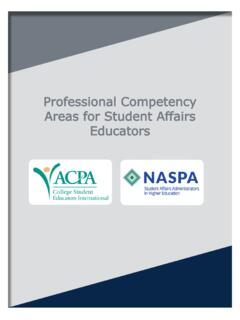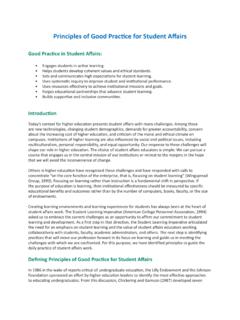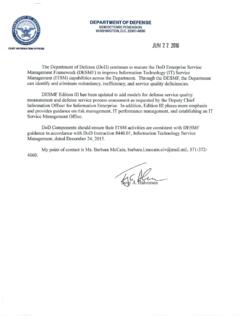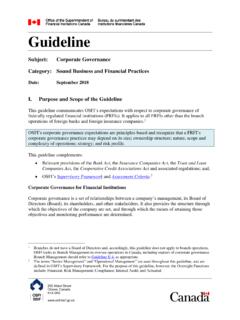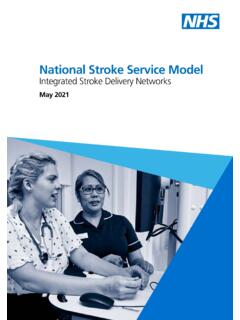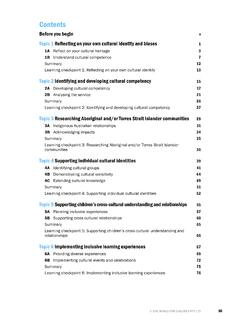Transcription of ACPA/NASPA Professional Competencies Rubrics
1 ACPA/NASPA Professional Competencies Rubrics2 Professional competency RubricsProfessional Competencies Rubrics Task ForceCo-Chairs:Ellen Meents-DeCaigny, (Co-Chair)Assistant Vice President for Student AffairsDePaul UniversityJonathan O Brien, (Co-Chair)Assistant Professor, Educational LeadershipCalifornia State University, Long BeachMembersCoco Du, of Residential LifeMacalester College Hayley Haywood, , Multicultural and First Generation Student SupportClark University Jerrid Freeman, President for Student AffairsNortheastern State University Martha Glass, of Assessment and Professional Development Virginia Tech Dustin Grabsch, Coordinator for Academic Support Initiatives & AssessmentTexas A & M University Jodi Koslow Martin, President for Student EngagementNorth Park University Jason Pina, President for Student AffairsOhio University Ken Schneck.
2 Professor, Leadership in Higher EducationBaldwin Wallace UniversityACPA College Student Educators International & NASPA Student Affairs Administrators in Higher Education3 Table of are competency Rubrics ?..4 Why Use Rubrics in Student Affairs?..5 How Can I Use These Rubrics ?..5 Graduate Program and Hiring Professional Development and RubricsAdvising and , Evaluation, and , Policy, and and Human and Ethical Justice and Learning and , Philosophy, and competency RubricsIntroductionThe competency Rubrics and their source document, Professional competency Areas for Student Affairs Educators (ACPA & NASPA, 2015), reflect decades of scholarship devoted to identifying the knowledge, skills, and dispositions for effective practice.
3 Researchers have studied student affairs Competencies from multiple perspectives, including chief student affairs officers and graduate preparation faculty (Burkard et al., 2005; Estanek et al., 2011; Herdlein, 2004; Dickerson et al., 2011; Herdlein, et. al., 2011), new professionals and supervisors (Cuyjet, Longwell-Grice & Molina, 2009), diversity educators (King & Howard-Hamilton, 2003), and the content of job descriptions (Hoffman & Breciani, 2012). Analyzing the findings of these and other studies, Herdlein, Riefler, and Mrowka (2013) concluded that the prominent competency areas were, multicultural/diversity issues and student development theory, followed by administrative topics such as law, research and assessment, budget and finance, ethics, campus organization, and structure (p.)
4 266).Informed by scholarship and motivated by the larger accountability movement in higher education, Professional associations have made significant contributions to the establishment of Professional standards. The current version of the Professional Competencies (ACPA & NASPA, 2015) and these Rubrics can be traced to a report from a steering committee convened by ACPA (2007), which proposed eight Competencies with outcomes distributed along basic, intermediate, and advanced levels. Two years later, a Joint Task Force on Professional Competencies and Standards was convened and proposed ten Competencies (ACPA & NASPA, 2010). Shortly after this publication, a team was formed by ACPA ( ) to write Rubrics that are the prototype for the current part of a regular review cycle, a new Joint Task Force on Professional Competencies (ACPA & NASPA, 2015) made a number of changes to the Competencies , which are described in that publication.
5 The Rubrics in this document reflect the most recent are competency Rubrics ?This document adapts the Professional competency Areas for Student Affairs Educators (ACPA & NASPA, 2015) into Rubrics . A rubric is a tool that professionals can use to assess their knowledge, skills, and dispositions across foundational, intermediate, and advanced levels of experience. Each rubric presents the definition of a single competency and distributes its outcomes in a table that lists multiple dimensions of the competency in rows and along a developmental scale in three The dimensions of each rubric are derived from the competency description and are listed along the left column.
6 They are aspirational and strengths-based, encouraging developmental progression in the domains of knowledge, skills, and dispositions for effective practice, as determined by the literature and expert practitioners. Knowledge includes the evolving body of student development and learning theories, relevant laws, policies and ethical ideals, as well as management and leadership concepts that guide student affairs practice. Skills are actions, best practices, and knowledge-based expertise, such as goal setting, interpersonal communication, use of technology, and assessment. Dispositions are relatively stable patterns of behavior that are grounded in an educator s values and motives, such as collaboration, critical thinking, tolerance ACPA College Student Educators International & NASPA Student Affairs Administrators in Higher Education5 Rubrics are a convenient way to convey expectations for performance and structure feedback in a uniform and concise way (Stevens & Levi, 2011).
7 They offer a dependable set of criteria that help student affairs practitioners to identify areas for growth, create a personal development plan, clarify responsibilities and outcomes, and facilitate consensus among colleagues about what constitutes good practice. Educators can use them to create learning outcomes, design curriculum, or evaluate conference programs and session competency of individuals, they are not valid instruments for measuring growth or comparing the performance of others. Users must adapt the Rubrics for their own goals and the context of their institution and job ambiguity, flexibility, and openness to constructive The scale has three levels: foundational; intermediate; and advanced.
8 Each level is a column, beginning to the right of the Dimension column. The outcomes within each column describe increasingly complex levels of knowledge and skills in each dimension. Precisely locating one s position on the scale is difficult since a variety of characteristics influence Professional development ( , lived experience, position in the organization, formal education, association involvement, etc.). It is reasonable to infer that graduate students and novice professionals are learning to apply individual Competencies at the foundational level, while senior-level professionals, who are presumably capable of synthesizing multiple Competencies , would occupy advanced levels.
9 Although the Rubrics can help to assess the Why Use Rubrics in Student Affairs?Mastery of outcomes in each dimension can be tracked in many ways, including observations, pre- and post-tests, formal coursework, or case study analysis. Users can document achievement by creating a scale for individual competency outcomes ( , Strongly Agree to Strongly Disagree) or adding additional rows or columns to write in evidence of can be used in a variety of contexts including Professional development, graduate preparation, employment and supervision, and Professional associations. Some suggestions are provided Can I Use These Rubrics ?Graduate Program Coordinators Include the Rubrics along with the Competencies , as required texts for introductory courses.
10 The Rubrics promote students reflection and self-assessment by showing them how proficiency develops over time, across the multiple dimensions that comprise each competency . Early in the first semester, ask students to identify their level of mastery in each competency area. This also helps program coordinators to focus on the areas where students need the most attention. Repeat this assessment in a year, and share the results with faculty advisors to discuss during an annual progress meeting. Offer a workshop for field-based experience supervisors. Not all supervisors for field-based experiences have knowledge of the Rubrics (or the Competencies ) so it might be helpful to host a session explaining the Rubrics to supervisors and how they might be incorporated into assignments of tasks and performance competency Rubrics Create and evaluate learning outcomes for field-based experiences using the Rubrics .
